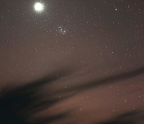The first deep sky atlas

From earliest times astronomers were aware that among the fixed stars there were a few, equally fixed but un-star-like objects which appeared to them as ‘misty patches’ or ‘little clouds’. These were the nebulae and their unique appearance and comparative rarity exercised the imagination of all who enquired into the nature of the universe.
Kenneth Glyn Jones, The Search for the Nebulae (1975)
WE 21ST-CENTURY AMATEUR astronomers are fortunate to have wonderfully detailed and accurate printed and computer-generated star charts to aid us in our explorations of the heavens. When I started observing in 1984, I was thrilled with Wil Tirion’s Sky Atlas 2000.0, published in 1981. Although I didn’t know it at the time, Tirion’s atlas was modelled on Antonín Becÿváÿ’s Atlas of the Heavens: Atlas Coeli 1950.0 (the 1958 edition). Before this, Norton’s Star Atlas, first published in 1910, was a favourite of many amateurs.
Most beginners start by hunting for the Messier objects and then graduate to more challenging deep sky wonders. Accurate and detailed charts make star-hopping much easier, and there’s even the option of computerised Go To telescopes complete with extensive self-contained databases. Experienced observers can log thousands of deep sky targets in the course of a lifetime. But it wasn’t always this way.
Starting with the invention of the telescope in the early 17th century, astronomers scanned the night sky with little guidance, slowly discovering ‘nebulae’ (misty objects of all kinds) and logging each new find. These discoveries were
You’re reading a preview, subscribe to read more.
Start your free 30 days



